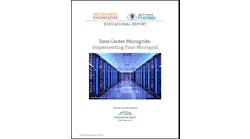When Russelectric, a Siemens business, first started working on the graphic seen below to help customers understand how advanced microgrid controls can empower modern microgrids to do far more than simply provide reliable backup power, we couldn’t help but notice that it looked a lot like the arrangement of a typical orchestra.
What is advanced microgrid control?
Very simply, it is the combination of hardware and software that creates a smart system to conduct an “orchestra” of many power assets to supply power and energy management that is like music in perfect harmony for the audience — on-site energy users.
Advanced microgrid controls require complete hardware solutions in the form of power control switchgear and state-of-the-art software. This combination provides control of a facility’s power supply assets — connecting, controlling and optimizing loads and generation sources to achieve a mix of benefits unique to each customer.
While some advanced microgrid control owners have the expertise on staff to manage the controls via a software dashboard, an advanced microgrid control vendor such as Russelectric will typically offer a combination of services and support to meet the comfort level of any business that could benefit from an advanced microgrid.
Advanced microgrids are for more than business reliance
Now is the fun part: getting to the beautiful music the symphony of energy assets and demand characteristics in a modern microgrid can make when conducted by advanced microgrid controls.
Given the increased instances of extreme weather and climate change, “business resilience” is the buzzword of the day, and the ability of advanced microgrids to provide reliable backup generation when the grid is out is certainly a source of considerable value for many businesses.
But for operations ranging from hospitals to university campuses to industrial sites to community microgrids, an advanced microgrid can offer that and so much more. In fact, there are four primary benefits:
- Power quality. Protecting a facility from utility power quality problems, such as by offsetting demand from the grid during periods of peak demand or severe weather events, via energy from a microgrid’s storage, generation assets and more.
- Business continuity. The resilience via backup generation that so many operations crave to mitigate costly consequences from losses of power.
- Energy cost reduction. Possible in many scenarios now given rising utility costs, fluctuating energy rates and the falling cost of on-site energy technologies like solar and battery storage.
- Greenhouse gas emissions reduction. Not just sending solar from a facility’s rooftop to the grid and hoping it helps create a cleaner grid, but leveraging solar assets by connecting them to the load through the advanced microgrid controls; this ensures power from on-site renewable resources is used at your facility to ensure its energy use produces minimal emissions.
These benefits are possible thanks to the advanced microgrid controller’s ability to conduct the orchestra. Just as a conductor helps bring discordant sounds into a harmonic balance, an advanced microgrid controller synchronizes the flow of electrons from various power supply assets to critical loads.
If power quality on the grid is fluctuating because of peak demand, for example, the controller can respond automatically by calling on energy from the microgrid’s battery storage reserves. If a business participates in a demand response program, this can also result in more revenue. For energy cost savings, the controller can optimize when the microgrid sends energy to the grid (a major financial benefit for operations in areas with net metering) and when the microgrid is serving facility loads, such as when utility rates are high in a time-of-use pricing structure.
The ability to connect clean power, such as from solar panels, to on-site demand is a boon for companies seeking to deliver on serious sustainability commitments, which is increasingly important as investor and customer expectations for corporate environmental, social and governance performance increases.
Lastly, when the grid inevitably does falter (as is happening with increasing frequency around the United States), advanced microgrid controls can place the microgrid into island mode to keep operations online, including isolating noncritical loads so that the system can serve critical loads as long as needed.
For an increasing number of operations, this symphony is music to their ears.
John Stark is marcom and product manager at Russelectric.







